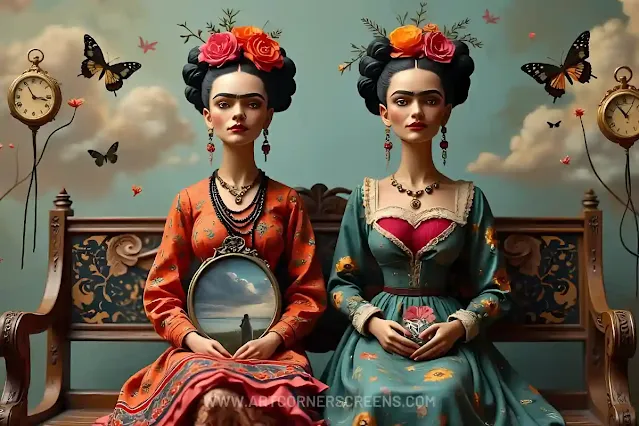 |
| Frida Kahlo's Symbolic Art |
Frida Kahlo Symbolic Art | The Two Fridas
Frida Kahlo The Two Fridas is a timeless example of how visual art can blend fine arts techniques with deep personal symbolism. Created in 1939 during one of the most challenging periods of her life, this masterpiece continues to inspire audiences around the globe. This article delves into the depth of The Two Fridas, its connection to renowned institutions like the Museum of Modern Art and the Museum of Fine Arts, and its impact on traditional and digital art mediums such as Substance Painter.
The Two Fridas | A Symbolic Masterpiece in Visual Art
Frida Kahlo The Two Fridas is a self-portrait that reveals the duality of her identity and emotional struggles. In this iconic Painting, she depicts two versions of herself: one dressed in a traditional Tehuana dress, symbolizing her Mexican heritage, and the other wearing a European-style white dress, reflecting Western influences and emotional vulnerability.
The imagery is rich with symbolism: exposed hearts connected by a single blood vessel represent the conflict between her cultural pride and the pain of her personal experiences. This blood vessel leads to a miniature portrait of Diego Rivera, her estranged husband, held by the traditional Frida, signifying their lingering connection. The European Frida attempts to sever this bond with surgical scissors but bleeds, highlighting her emotional anguish.
By blending fine art techniques with profoundly personal themes, The Two Fridas transcends traditional self-portraits and becomes a universal narrative of identity, love, and resilience.
Exploring Kahlo Fine Arts Techniques | From Frescoes to Modern Influences
Frida Kahlo artistry reflects a mastery of fine arts techniques, influenced by her exposure to frescoes and traditional Mexican art. While her husband, Diego Rivera, was known for large-scale fresco murals, Kahlo adapted these principles to her canvases, creating detailed works that tell intimate stories.
In The Two Fridas, her precision in rendering fabric textures, blood vessels, and anatomical details showcases her technical expertise. The stormy background, reminiscent of fresco compositions, adds a dramatic atmosphere, further amplifying the Painting's emotional depth's use of layers in her storytelling—blending realism, surrealism, and symbolism—bridges the gap between traditional fine arts and modern visual narratives.
Her meticulous approach inspires artists in various mediums, from traditional oil painting to digital tools like Substance Painter. These tools allow modern creators to reinterpret her iconic works with hyper-realistic textures and enhanced visual storytelling, proving her relevance in contemporary art.
The Museum of Modern Art and Museum of Fine Arts: Preserving Kahlo Legacy
Institutions like the Museum of Modern Art (MoMA) and the Museum of Fine Arts play a vital role in preserving and showcasing Kahlo legacy. These museums allow art enthusiasts to experience her works' scale, texture, and emotional impact in person. MoMA's dedication to modern and contemporary art has solidified Kahlo influence on visual art.
Meanwhile, the Museum of Fine Arts often emphasizes its role in merging fine arts traditions with innovative narratives. Exhibiting The Two Fridas in such esteemed spaces enhances its historical and cultural significance, enabling viewers to appreciate its intricate details and profound symbolism firsthand. For art lovers, visiting these institutions provides an unparalleled understanding of Kahlo struggles and the cultural heritage of her masterpieces.
From Painting with a Twist to Digital Art | Kahlo Influence Today
Frida Kahlo influence extends far beyond traditional fine arts. Modern art platforms, workshops, and tools like Painting with a Twist and Substance Painter enable artists and enthusiasts to engage creatively with her techniques. In Painting with Twist sessions, participants can recreate Kahlo works, including The Two Fridas, while learning about her use of color, symbolism, and storytelling. These social workshops make fine arts accessible and foster an appreciation for her genius among diverse audiences.
Similarly, digital tools like Substance Painter allow artists to explore Kahlo themes with new dimensions. Imagine digitally recreating the intricate embroidery of the Tehuana dress or the transparency of the exposed hearts with modern rendering techniques. Such innovations bridge the gap between Kahlo traditional artistry and today's technological advancements, ensuring her relevance across generations.
Why The Two Fridas Remains a Fine Arts Icon
Frida Kahlo The Two Fridas is more than just a painting; it is a narrative woven with the threads of identity, love, and cultural pride. By blending fine arts techniques, elements of frescoes, and symbolic storytelling, Kahlo created a masterpiece that resonates with audiences around the globe.
Whether showcased in the Museum of Modern Art, celebrated at the Museum of Fine Arts, or reimagined through Painting with a Twist and Substance Painter, The Two Fridas continues to inspire. It stands as a testament to Kahlo genius in transforming personal pain into universal art, bridging the past and future of visual art.

